Is Your Business Disaster Ready?
28 June 2023
Planning for disaster response is as important for your business as planning for growth or for passing on ownership to someone else. In fact, some would argue that being fully prepared for emergencies is a basic for managing a business.

Business disaster planning includes identifying the types of emergencies or disasters that potentially could impact your business, the level of severity of impact on your business operations, actions you and your staff will take in preparing for and responding to the disaster, and how you will get your business up and operating afterwards.
Emergencies or disasters come in many shapes and sizes. They may be natural events that stop your business for a short time, such as intense heatwaves or cyclones. They may be emergencies that only impact your business such as IT security breaches or failure to comply with industry regulations. Or they may be major disasters impacting your entire community such as pandemic or loss of electricity supply. Other emergencies that you may need to consider include disasters indirectly impacting your business which could affect access to your business, such as fire in a nearby property, a hostage situation, or a major incident such as a multi-fatality accident, or in our case a strike by airline personnel.
Sometimes events in one place can impact business in other places, such as internet outages or changes to supply services. As businesses depend increasingly on internet-based services, outages or hackings are having a more diverse and serious impact globally. Having plans in place to keep your business operating without access to online services, or when a supplier collapses, is increasingly recommended for all businesses, large and small.
When disaster strikes, making sure your employees are all safe and able to return to work as soon as possible should be the first priority. As we found with the COVID pandemic, being able to pivot quickly to other ways of working, such as working-from-home, was the hallmark of those businesses that stayed afloat. In the case of expected or unexpected natural disasters, the business owner should ensure all staff know what to do (and what not to do). Inductions for new staff as well as regular rehearsals for all staff should be on your calendar. This includes being clear about who takes responsibility for the business assets (records, equipment, buildings, products etc) and what those responsibilities entail. Different staff may be designated with different responsibilities for business assets so that the stress of protecting them in an emergency is shared.
Maintaining communications with clients and customers should also be part of the disaster response plan. Is there a phone tree to communicate quickly with staff and customers? Have you designated an alternative site for business activities? What various forms of communication are available for staff as well as clients or customers?
If your business provides services to clients who depend on it, such as a community-based aged care service, your plan should include detailed responses for managing service support to these people. Who will contact the clients, what information will be provided to them and when (and who will be responsible for preparing the messages), and what alternative arrangements will swing into gear are examples of considerations in this case.
Remember supply chains as well, for example, goods that have been ordered may need to be put on hold if no storage is available, or goods that have been lost or could be lost in an impending disaster may need to have their delivery dates changed.
Other factors to include in the plan are designating a spokesperson (with alternative back-ups) to release information to the public or to customers or clients, including what messages will be released and how that information will be disseminated especially when social media is being used. Ensuring that key business records are stored safely and well backed up, such as having cloud-based records, is essential for disaster plans. Who will do this and who has access, for example to passwords? Are insurance documents up to date and saved securely, and do you have insurance for all aspects of your business, from goods and chattels through to employees and cash flow?
Your disaster response plan should also include detailed planning for recovery. The recovery plan includes the names, responsibilities and contact details of the team that will coordinate and manage the recovery, including alternatives to replace key team members if they are not available. Who will make the decisions, how will recovery be staged from highest to lowest priorities? How will communications be handled for customers, suppliers, employees and the media in the short-term through to full recovery? How will cash flow or direct client services be managed during the recovery period?
Risk assessment and disaster planning is recommended at least annually, and better still, reviewed regularly throughout the year to ensure it is up-to-date and changes to your business are integrated into the plan (such as staff changes, expansion of new services, changes to supply chains etc). Regular testing of the plan must take place, and consulting with your local disaster response services to ensure your plan covers as much as possible is recommended.
The Red Cross Emergency Services Volunteers Team can be contacted for assistance with business disaster planning on 50506 or email redcrossnorfolkisland@gmail.com